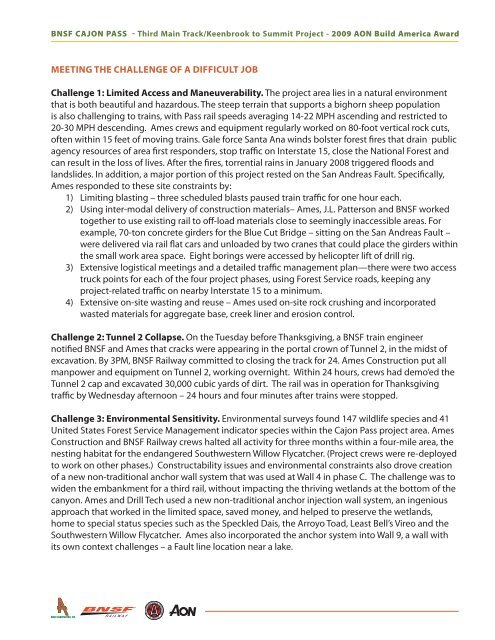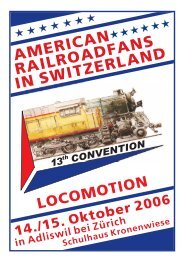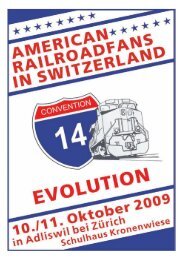BNSF CajoN PaSS - US-Railroad-Shop
BNSF CajoN PaSS - US-Railroad-Shop
BNSF CajoN PaSS - US-Railroad-Shop
- No tags were found...
You also want an ePaper? Increase the reach of your titles
YUMPU automatically turns print PDFs into web optimized ePapers that Google loves.
<strong>BNSF</strong> Cajon Pass - Third Main Track/Keenbrook to Summit Project - 2009 AON Build America AwardMeeting the challenge of a difficult jobChallenge 1: Limited Access and Maneuverability. The project area lies in a natural environmentthat is both beautiful and hazardous. The steep terrain that supports a bighorn sheep populationis also challenging to trains, with Pass rail speeds averaging 14-22 MPH ascending and restricted to20-30 MPH descending. Ames crews and equipment regularly worked on 80-foot vertical rock cuts,often within 15 feet of moving trains. Gale force Santa Ana winds bolster forest fires that drain publicagency resources of area first responders, stop traffic on Interstate 15, close the National Forest andcan result in the loss of lives. After the fires, torrential rains in January 2008 triggered floods andlandslides. In addition, a major portion of this project rested on the San Andreas Fault. Specifically,Ames responded to these site constraints by:1) Limiting blasting – three scheduled blasts paused train traffic for one hour each.2) Using inter-modal delivery of construction materials– Ames, J.L. Patterson and <strong>BNSF</strong> workedtogether to use existing rail to off-load materials close to seemingly inaccessible areas. Forexample, 70-ton concrete girders for the Blue Cut Bridge – sitting on the San Andreas Fault –were delivered via rail flat cars and unloaded by two cranes that could place the girders withinthe small work area space. Eight borings were accessed by helicopter lift of drill rig.3) Extensive logistical meetings and a detailed traffic management plan—there were two accesstruck points for each of the four project phases, using Forest Service roads, keeping anyproject-related traffic on nearby Interstate 15 to a minimum.4) Extensive on-site wasting and reuse – Ames used on-site rock crushing and incorporatedwasted materials for aggregate base, creek liner and erosion control.Challenge 2: Tunnel 2 Collapse. On the Tuesday before Thanksgiving, a <strong>BNSF</strong> train engineernotified <strong>BNSF</strong> and Ames that cracks were appearing in the portal crown of Tunnel 2, in the midst ofexcavation. By 3PM, <strong>BNSF</strong> Railway committed to closing the track for 24. Ames Construction put allmanpower and equipment on Tunnel 2, working overnight. Within 24 hours, crews had demo’ed theTunnel 2 cap and excavated 30,000 cubic yards of dirt. The rail was in operation for Thanksgivingtraffic by Wednesday afternoon – 24 hours and four minutes after trains were stopped.Challenge 3: Environmental Sensitivity. Environmental surveys found 147 wildlife species and 41United States Forest Service Management indicator species within the Cajon Pass project area. AmesConstruction and <strong>BNSF</strong> Railway crews halted all activity for three months within a four-mile area, thenesting habitat for the endangered Southwestern Willow Flycatcher. (Project crews were re-deployedto work on other phases.) Constructability issues and environmental constraints also drove creationof a new non-traditional anchor wall system that was used at Wall 4 in phase C. The challenge was towiden the embankment for a third rail, without impacting the thriving wetlands at the bottom of thecanyon. Ames and Drill Tech used a new non-traditional anchor injection wall system, an ingeniousapproach that worked in the limited space, saved money, and helped to preserve the wetlands,home to special status species such as the Speckled Dais, the Arroyo Toad, Least Bell’s Vireo and theSouthwestern Willow Flycatcher. Ames also incorporated the anchor system into Wall 9, a wall withits own context challenges – a Fault line location near a lake.R A I L W A Y




